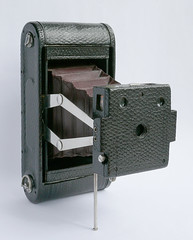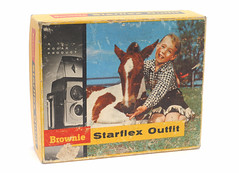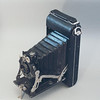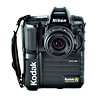Kodak
Eastman Kodak Co., Rochester (NY), is an American film maker and camera maker. For at least three quarters of the 20th century it played the dominant role in worldwide photography business.
Contents
History
In 1879 George Eastman, amateur photographer and employee of a bank in Rochester, had invented an emulsion-coating machine for mass production of dry plates and got a patent on it in England. In 1881 he and Rochester's local buggy whip manufacturer Henry A. Strong founded the Eastman Dry Plate Company in the town in the north of the state of New York (USA).
In 1883, a year after having solved troubles with bad quality gelatine that spoiled film plates, the company moved to a four-story building which later got the address 343 State Street, longtime headquarter address of the company. In 1884 Eastman and Strong transformed their partnership to a corporation for which they gathered the first shareholders. In 1885 the American Film was introduced, a paper roll film which needed a special development process. This was used later in the first two Kodak cameras. However Eastman knew that he needed a transparent film for the future, and hired a chemist as research scientist. The transparent roll film could be delivered in 1889.
Eastman's goal in life was to simplify and to popularize photography. The first step towards that goal was the "Kodak" camera he introduced in 1888 which had a built-in 100-exposure paper roll film costing $25, a huge amount. The box camera had to be sent back to the factory once all the exposures had been used. The customers got their cameras back with new film roll loaded into it, and the image prints. In 1890 a Kodak folding camera with built-in 48 exposure film roll followed. After years of advertising the brand Kodak the company was renamed to Eastman Kodak Co. In 1900 Eastman had reached his goal, offering the Brownie rollfilm camera which cost only $1 including a 6 exposure film. Further film rolls cost just 15 cents. The Brownie camera series was continued until 1970.
Kodak used to have autonomous branches in other countries, which developed their own lines of products, as Ford did for cars. The German branch Kodak AG, which made the famous Retina models, is discussed in a separate page, as is Kodak Ltd. (UK). At its peak Kodak's international plants were
- in Canada: Kodak Canada Limited, Toronto
- in UK: Kodak Limited, several plants
- in France: Kodak Pathé, several plants
- in Germany: Kodak AG, Stuttgart (formerly Nagel)
- in Australia: Kodak Australasia Pty. Ltd., Coburg
- in Argentina: Kodak Argentina S.A.I.C., Buenos Aires
- in Brazil: Kodak Brasileira Comércio e Indústria Ltda., Sao Paolo
- in Mexico: Kodak Industrial, S.A. de C.V.
With exception of the Mexican plant all these international branches made cameras. The most U.S. plants outside Rochester were specialized on producing basic materials like gelatine (Peabody/Massachusetts),
plastics (Longview/Texas), chemicals (Batesville/Arkansas), polyester fibre (Columbia/S.C.), and basic materials for film making and others (Kingsport/Tennessee). Some of the films and plates were made in Windsor/Colorado.
At its peak, the company was huge and made everything connected with photography: cameras, lenses (including some of the best lenses of the mid-20th century), film, and processing chemicals and equipment, in addition to photographic materials used in the graphic arts industry (for example, for printing). It also conducted important photographic research and development. 60.000 people were working for Kodak in Rochester. In 1966 the company had 100.000 employees worldwide.
The most popular Kodak cameras were the ones for 126 film cartridges. The first of these cameras was launched in 1963. Until 1976 60.000.000 Instamatic cameras had been sold, six times more than all competitors together sold of this camera type, and also six times more than Kodak's previous big success that it had with the Brownie Star camera series (10 Mio. Starflex, Starmite, and Starflash, made from 1957 to 1962). Another huge success was achieved with Kodak's type 110 pocket film cartridges and pocket cameras which were introduced in 1972. But this time the concurrent companies took a larger share of the market by abandoning own miniature film formats and introducing smart pocket cameras for 110 film instead. Kodak's decline began when it flopped with another miniature film format, the disc film, in the 1980s.
In the year 1976 camera engineer Steven Sasson developed Kodak's first digital still camera (for 0.1 megapixel black&white exposures), based on newest CCD technology. Kodak didn't realize the huge value of this invention and delayed the production of digital consumer cameras until it was too late to enter the digital market with the huge success that Kodak was used to have. In August 2006 it abandoned the production of digital cameras by outsourcing the production to Flextronics, an all-and-everything OEM manufacturer in Singapore.
35mm film
- Kodak Signet 30
- Kodak 35 RF
- Kodak Signet 35
- Kodak Stereo
- Kodak disposable
- Kodak S100
- Kodak Ektra
- Retina: see Kodak AG
828 Bantam film
Roll film
101 film
105 film
116 film
- No. 1A Speed Kodak
- No. 1A Pocket Kodak
- Kodak No. 1A Folding Autographic Junior
- Kodak No. 2A Folding Autographic Brownie
- Kodak No. 2A Folding Pocket Brownie
- Cartridge Hawk-Eye 2A
118 film
120 film
120 film, folder
- Kodak No. 120
- Kodak No. 2 Hawkette
- Pocket Kodak No. 1
- Pocket Kodak No. 1a
- Pocket Kodak No. 2c
- Pocket Kodak No. 3a
- Pocket Kodak Junior No. 1
- Pocket Kodak Junior No. 1a
- Pocket Kodak No. 1 series II with autographic 120 film
- Pocket Kodak No. 1a series II
- Pocket Kodak Special No. 1
- Pocket Kodak Special No. 1a
- Pocket Kodak Special No. 2c
- Pocket Kodak Special No. 3
120 film, box
- No. 2 Beau Brownie (original Art Deco fancy camera)
- Brownie Junior 120
- 50th Anniversary 1880 to 1930
- Hawk-eye No. 2
122 film
- No. 3A Folding Pocket Kodak
- No. 3A Autographic Kodak
- No. 3A Autographic Kodak Special (1916: Kodak's first rangefinder camera)
123 film
127 film
- Kodak Bullet
- Kodak Boy Scout
- Vest Pocket Kodak
- Vest Pocket Autographic
- Kodak Brownie 127
- Kodak Brownie Starmite
620 film
- Kodak Duaflex I/II/II/IV
- Kodak Hawkeye
- Jiffy Kodak Six-20
- Jiffy Kodak Series II
- Kodak Six-20 Brownie Junior
- Kodak Vigilant Junior Six-20
- Kodak Reflex II (TLR)
616 film
- Junior Six-16
- Brownie Junior
- Target SIX-16
- Brownie Special six-16
Plate and sheet film
Folding plate cameras
- Film Premo No.1
- 3A Film Plate Special Premo (3.25x5)
large format
- Kodak Master View Camera 4x5
- Eastman View Camera No. 2-D (5x7)
- Eastman View Camera No. 2-D (8x10)
Cartridge film
126 film
- Instamatic 44
- Instamatic 50
- Instamatic 100
- Instamatic 104
- Instamatic 124
- Instamatic 134
- Instamatic 204
- Instamatic 304
- Instamatic 404
- Instamatic 700
- Instamatic 814
- Hawkeye Instamatic R4
- Instamatic S-10
- Instamatic X-15F
- Instamatic X-30
- Instamatic X-35F
- Instamatic X-45
110 film
- Star 110 Camera
- Pocket Instamatic 10
- Pocket Instamatic 20
- Pocket Instamatic 30
- Pocket Instamatic 40
- Pocket Instamatic 50
- Pocket Instamatic 60
- Fisher-Price 100 Camera
- Mickey-Matic Camera
APS film
- Advantix 2000AUTO
- Advantix 4100ix zoom
- Advantix F300
- Kodak Advantix C370
- Advantix C400
- Advantix T550
Special film
Kodak disc film
- Kodak disc 3000
- Kodak disc 4000
- Kodak disc 4100
Instant film
- Kodak Analyst
- Kodak Champ Kodamatic
- Kodak Colorburst 50
- Kodak EK2
- Kodak EK4
- Kodak EK6
- Kodak The Handle
- Kodak Happy Times (Coca-Cola) Camera
- Kodak Kodamatic 960
- Kodak Party Time
- Kodak Party Time II
- Kodak Partyflash II
- Kodak Pleaser
- Kodak Pleaser II
- Kodak Trimprint 920
- Kodak Trimprint 940
Digital
just display, no optical finder
- Kodak Easyshare C433, C875
- Kodak Easyshare LS755
- Kodak Easyshare One 4MP, 6MP
- Kodak Easyshare V530, V570, V603, V610, V705
display and optical finder
- Kodak DC20, DC25, DC40, DC50 Zoom, DC200, DC200 Plus, DC210, DC210 Plus, DC215, DC220, DC220 Pro Edition, DC240, DC260, DC260 Pro Edition, DC265, DC290, DC3200, DC3400, DC3800, DC4800, DC5000
- Kodak Easyshare DX3215, DX3500, DX3600, DX3700, DX3900, DX4330, DX4530, DX4900, DX6340, DX6440, DX7440, DX7630
- Kodak Easyshare CX4200, CX4210, CX4230, CX4300, CX4310, CX6200, CX6230, CX6330, CX6445, CX7220, CX7300, CX7310, CX7330, CX7430, CX7525, CX7530
- Kodak Easyshare CW330
- Kodak Easyshare CD33, CD40, CD43
- Kodak Easyshare C300, C310, C315, C330, C340, C360, C503, C530, C533, C603, C643, C663, C703, C743
- Kodak Easyshare LS420, LS443, LS633, LS743, LS753
- Kodak Easyshare V550, V705
- Kodak Easyshare Z700, Z730, Z760
display and electronic finder
- Kodak Easyshare DX6490, DX7590
- Kodak Easyshare P712, P850, P880
- Kodak Easyshare Z612, Z650, Z710, Z740, Z7590
DSLR
Nikon AF mount
- Kodak DCS 100 (back attached to a Nikon F3)
- Kodak DCS 200 (back attached to a Nikon F801s/N8008s)
- Kodak DCS 410 (back attached to a Nikon F90/N90)
- Kodak DCS 420 (back attached to a Nikon F90/N90 or F90X/N90s)
- Kodak DCS 460 (back attached to a Nikon F90X/N90s)
- Kodak NC2000 (back attached to a Nikon F90/N90 or F90X/N90s)
- Kodak NC2000e (back attached to a Nikon F90X/N90s)
- Kodak DCS 620 / DCS 620x (based on a Nikon F5)
- Kodak DCS 660 / DCS 660M (based on a Nikon F5)
- Kodak DCS 720x (based on a Nikon F5)
- Kodak DCS 760 (based on a Nikon F5)
- Kodak DCS Pro 14n
- Kodak DCS Pro SLR/n
Canon EF mount
- Kodak EOS-DCS 1 (back attached to a Canon EOS-1N)
- Kodak EOS-DCS 3 (back attached to a Canon EOS-1N)
- Kodak EOS-DCS 5 (back attached to a Canon EOS-1N)
- Kodak DCS 520 (based on a Canon EOS-1N and also sold as Canon D2000)
- Kodak DCS 560 (based on a Canon EOS-1N)
- Kodak DCS Pro SLR/c
Nikon Pronea mount
- Kodak DCS 315 (based on a Nikon Pronea 600i)
- Kodak DCS 330 (based on a Nikon Pronea 600i)
Resources
| photography related industry in Rochester (New York) |
| American Camera | Bausch & Lomb | Blair | Century | Crown Optical Co. | Elgeet | Folmer & Schwing | Gassner and Marx | Graflex | Gundlach | Ilex | JML | Kodak | Milburn | Monroe | PMC | Ray | Reichenbach, Morey and Will | Rochester Camera and Supply Co. | Rochester Optical Co. | Rochester Panoramic Camera Co. | Seneca | Sunart | Walker | Webster Industries | Wollensak |
| and in Rochester (Minnesota) |
| Conley |
| external links |
| graflex.org - Rudolf Kingslake's "Optical industry in Rochester (N.Y.)" |
Books:
- KODAK Milestones, 1880-1980. Rochester 1980
Websites in English:
- Kodak Classics by Mischa Koning ~ A site with manuals, historical background information, articles and pictures on nearly 500 Classic Kodak cameras.
- The Kodak Collector's Page by Walker Mangum, with many information including an article about the Kodak roll film numbers by Thom Bell
- Kodak manuals, booklets and other historical literature (some in PDF and some in HTML) at www.orphancameras.com
- Kodak DCS series DSLRs at Photography in Malaysia
- Flickr group "Kodak"
Websites in French:
- Kodak page at Collection G. Even's site
- Cameras and User manuals at www.collection-appareils.com













